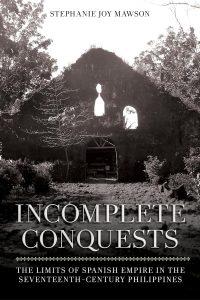In Incomplete Conquests: The Limits of Spanish Empire in the Seventeenth-Century Philippines, Stephanie Joy Mawson considers histories of resistance to colonialism in the Philippines during the 1600s. While it relies on Spanish archival rather than indigenous sources, Cai Barias deems the book a worthwhile contribution to the understanding of how marginalised communities in the Philippines responded to colonial agents. This post was originally published on the LSE Southeast Asia Blog.
Incomplete Conquests: The Limits of Spanish Empire in the Seventeenth-Century Philippines. Stephanie Joy Mawson. Cornell University Press. 2023.
 This summer I began to study my own Ibanag roots, and as a budding historian, I first searched for what had been written about my father’s native Cagayan Valley. Reaching out to relatives and neighbours in Tuguegarao brought me into the company of Ibanag anthropologists, archaeologists, and historians. From my own search and their shared expertise, I found that the academic literature on Ibanag history, and the indigenous peoples of the Cagayan Valley more broadly, was regrettably scarce. The opportunity to review Stephanie Joy Mawson’s monograph, Incomplete Conquests: The Limits of Spanish Empire in the Seventeenth-Century Philippines was a welcome change of pace, and in the first few paragraphs I began to imagine myself alongside her, standing atop the Calvary Hills in Iguig to view the vast expanse of the Cagayan Valley from above.
This summer I began to study my own Ibanag roots, and as a budding historian, I first searched for what had been written about my father’s native Cagayan Valley. Reaching out to relatives and neighbours in Tuguegarao brought me into the company of Ibanag anthropologists, archaeologists, and historians. From my own search and their shared expertise, I found that the academic literature on Ibanag history, and the indigenous peoples of the Cagayan Valley more broadly, was regrettably scarce. The opportunity to review Stephanie Joy Mawson’s monograph, Incomplete Conquests: The Limits of Spanish Empire in the Seventeenth-Century Philippines was a welcome change of pace, and in the first few paragraphs I began to imagine myself alongside her, standing atop the Calvary Hills in Iguig to view the vast expanse of the Cagayan Valley from above.
Mawson’s deeply researched book approaches the seventeenth century from the limits of Spanish empire, and elucidates how indigenous and external threats, as much as internal Spanish shortcomings, limited Spanish imperial expansion in the Philippines.
Mawson’s deeply researched book approaches the seventeenth century from the limits of Spanish empire, and elucidates how indigenous and external threats, as much as internal Spanish shortcomings, limited Spanish imperial expansion in the Philippines. Mawson’s work rests on three main arguments. First, Mawson argues that the Spanish colonial apparatus was thinly and unevenly spread through the archipelago. Second, Mawson argues that the Spanish adapted indigenous systems of labour and belief into their own practices of governance, often with the effect of undermining their own authority. And third, by focusing on the Cagayan Valley and surrounding mountain communities, Mawson argues that the imposed distinction between highland and lowland colonial histories is historically inaccurate.
Incomplete Conquests is organised roughly thematically into seven chapters that together bring the Spanish empire into fuller view. Chapters One and Seven best demonstrate the internal limitations of Spanish colonial authority. Chapter One focuses on moments of indigenous resistance in the Philippines between 1600-1663. These crises were previously characterised as exceptional, but Mawson argues that they were endemic and inevitable due to a weak economy, political competition from indigenous datus and the Dutch, the disintegration of alliances with indigenous people, and the growth of trade with China in the port of Manila. Chapter One lays the groundwork for the rest of her narrative and demonstrates the financial and political weakness of the Spanish, as well as their struggles to maintain personnel and a physical presence throughout Luzon. This argument is further expanded in Chapter Seven, in which Mawson argues that even in the colonial seat of power, Manila, the Spanish did not wield total authority over inhabitants. Mawson finds that Spanish power in Manila was exerted through law and bureaucracy, while Chinese inhabitants wielded power economically and thus came to control the city’s food supply.
The limitations of Spanish authority had significant implications for the changes that they were able to, or not, impose on indigenous social structures in the seventeenth century.
The limitations of Spanish authority had significant implications for the changes that they were able to, or not, impose on indigenous social structures in the seventeenth century. In Chapters Two, Three, and Four, Mawson argues that the Spanish adapted to pre-Hispanic social, spiritual, and economic structures to maintain their authority. In Chapter Two, Mawson argues that pressure from indigenous elite allies forced the Spanish to adopt pre-Hispanic social and economic structures, like debt bondage. Mawson also considers how the continuation of debt bondage further entrenched the divide between wealthy and poor indigenous peoples, and how the latter overwhelmingly turned to rebellion in response to this system. Chapter Three turns to Spanish efforts at conversion against the backdrop of the indigenous spiritual landscape. Mawson considers both the literal landscape and various communities’ beliefs in spirits and signs embedded in the natural world, and missionaries’ attempts to move indigenous peoples into Spanish settlements. Finally, in Chapter Four, Mawson details the politics of slave raiding in the southern regions of the Philippine archipelago and argues that Moro leaders used slave raids deliberately to destabilise Spanish presence in the Visayas. Moro leaders also engaged in diplomacy with the Spanish and were often able to sway negotiations in their favour. Together, these three chapters show how indigenous peoples were able to maintain aspects of their politics, beliefs, and in the case of the Moros, their land, despite myriad efforts to disrupt pre-Hispanic ways of life.
Mawson details the politics of slave raiding in the southern regions of the Philippine archipelago and argues that Moro leaders used slave raids deliberately to destabilise Spanish presence in the Visayas.
Chapters Five and Six focus on the process of colonisation in the Cagayan Valley and collectively demonstrate that highland and lowland histories were intimately connected throughout. Chapter Five brings the reader to the Cagayan Valley and surrounding mountain communities to show how autonomous mountain communities and lowland fugitives moved to and from the mountains. Mawson finds that the mountains offered spaces of refuge for indigenous peoples looking to leave Spanish-controlled areas, and that the Spanish were largely unable to navigate the terrain. Chapter Six details Cagayan insurgencies from 1572-1745 and expands the argument that upland and lowland histories were intertwined: this time through social connections including trade and kinship networks. Both chapters highlight how Cagayan communities resisted Spanish incursions, by attacking settlements, threatening allies, and moving throughout the region, as early as 1580s. Through such resistance, indigenous peoples in Cagayan limited Spanish settlement in the north for the duration of seventeenth century. Mawson’s focus on the Cagayan Valley is perhaps this book’s most meaningful intervention, as few studies of this region during the seventeenth century exist.
Mawson’s focus on the Cagayan Valley is perhaps this book’s most meaningful intervention, as few studies of this region during the seventeenth century exist.
Throughout Incomplete Conquests, Mawson relies a great deal on Spanish archives with the intention of “reading the silences” for indigenous agency. On the one hand, this archive allows Mawson to recreate moments of Spanish expansion and retreat in detail. Indeed, the use of Spanish sources to demonstrate imperial weakness is appropriate and challenges a historiography that overattributes success to the Spanish empire. On the other hand, however, this method necessarily limits the reader to impressions of indios as mediated through Spanish eyes and ears. Mawson works to challenge colonial characterisations of slave raiding and headhunting as “savagery” by framing such practices within broader Southeast Asian cosmographies but falls short of including original research utilising non-colonial sources. Including a greater diversity of sources, perhaps even non-textual indigenous sources, would have only enriched Mawson’s work.
For those interested in the history of Cagayan Valley, I recommend reading this book alongside work by Cagayano researchers and academics who do the work to bridge the gap between colonialism and indigenous cultural revival
Overall, Incomplete Conquests is a thorough and engaging book and would benefit students of Philippine history, Iberian empire, and Southeast Asia alike. For those interested in the history of Cagayan Valley, I recommend reading this book alongside work by Cagayano researchers and academics who do the work to bridge the gap between colonialism and indigenous cultural revival including the Cagayan Heritage Conservation Society and the Cagayan Museum and Historical Research Center.
This book review is published by the LSE Southeast Asia blog and LSE Review of Books blog as part of a collaborative series focusing on timely and important social science books from and about Southeast Asia. This review gives the views of the author, and not the position of the LSE Review of Books blog, the LSE Southeast Asia Blog, or the London School of Economics and Political Science.
Main Image Credit:







